
Millets are a highly varied group of small-seeded grasses, widely grown around the world as cereal crops or grains for fodder and human food. Most species generally referred to as millets belong to the tribe Paniceae, but some millets also belong to various other taxa.
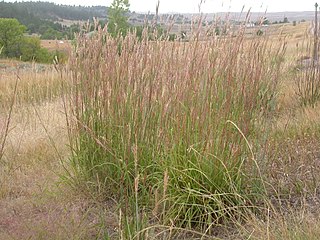
Andropogon gerardi, commonly known as big bluestem, is a species of tall grass native to much of the Great Plains and grassland regions of central and eastern North America. It is also known as tall bluestem, bluejoint, and turkeyfoot.

Agrostis stolonifera is a perennial grass species in the family Poaceae.

Johnson grass or Johnsongrass, Sorghum halepense, is a plant in the grass family, Poaceae, native to Asia and northern Africa. The plant has been introduced to all continents except Antarctica, and most larger islands and archipelagos. It reproduces by rhizomes and seeds.

Albert Spear Hitchcock was an American botanist and agrostologist.
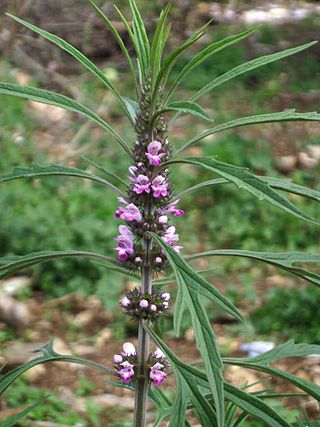
Leonurus sibiricus, commonly called honeyweed or Siberian motherwort, is an herbaceous plant species native to China, Mongolia, and Siberia. It has verticillaster inflorescence. It is naturalized in many other parts of the world, including South, Central and North Americas.

Sisyrinchium montanum, the blue-eyed-grass, American blue-eyed-grass, or strict blue-eyed grass, is a grass-like species of plant from the genus Sisyrinchium, native to northern North America from Newfoundland west to easternmost Alaska, and south to Pennsylvania in the east, and to New Mexico in the Rocky Mountains. It has also been introduced to parts of France, likely during the First World War.

Chloris virgata is a species of grass known by the common names feather fingergrassfeathery Rhodes-grass and feather windmill grass.

Danthonia decumbens is a species of grass commonly known as the heath grass, heath-grass, or staggers grass It is a tussock grass native to Europe and adjacent parts of Asia and North Africa. It may also be native to Newfoundland and Nova Scotia.

Paspalum dilatatum is a species of grass known by the common name dallisgrass, Dallas grass, or sticky heads. It is native to Brazil and Argentina, but it is known throughout the world as an introduced species and at times a common weed. Its rapid growth and spreading rhizomes make it an invasive pest in some areas. It is present in the southern half of North America, southern Europe, much of Africa, Australia, New Zealand, and many tropical and subtropical areas.

Paspalum distichum is a species of grass. Common names include knotgrass, water finger-grass, couch paspalum, eternity grass, gingergrass, and Thompson grass. Its native range is obscure because it has long been present on most continents, and in most areas it is certainly an introduced species. Its native range probably includes parts of the tropical Americas.

Bothriochloa ischaemum is a species of perennial grass in the family Poaceae, found throughout much of the world. It is commonly known as yellow bluestem. Two varieties are recognized, of which Bothriochloa ischaemum var. ischaemum is native to Europe, Asia, and Africa and naturalized elsewhere, and var. songarica is native to Asia and naturalized elsewhere. Var. songarica is an invasive weed in Texas, where it is known as "King Ranch bluestem"; it has displaced native grasses in large areas of central and south Texas.

Setaria verticillata is a species of grass known by the common names hooked bristlegrass, rough bristle-grass and bristly foxtail. It is native to Europe, but it is known on most continents as an introduced species and often a noxious weed. It is a hardy bunchgrass which grows in many types of urban, cultivated, and disturbed habitat. It is a weed of many types of agricultural crops, growing in vineyards and fields. Herbicide-resistant strains have been noted.

Jarava ichu, commonly known as Peruvian feathergrass, ichhu, paja brava, paja ichu, or simply ichu, is a grass species in the family Poaceae native to the Americas. It is found growing in a vast area: Mexico, Guatemala, Costa Rica, El Salvador, Venezuela, Bolivia, Colombia, Ecuador, Peru, Chile, and Argentina. It is a common grass of the Andean altiplano. It is used as fodder for livestock.
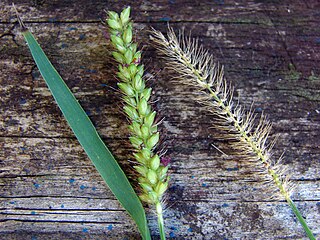
Setaria parviflora is a species of grass known by the common names marsh bristlegrass, knotroot bristle-grass, bristly foxtail and yellow bristlegrass. It is native to North America, including Mexico and the United States from California to the East Coast, Central America and the West Indies, and South America.
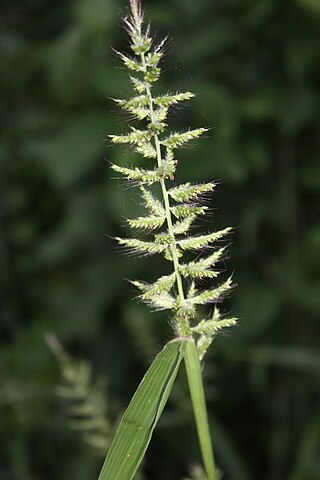
Setaria barbata, with common names bristly foxtail grass, corn grass, Mary grass, and East Indian bristlegrass, is a species of grass in the family Poaceae native to tropical Africa and tropical Asia.
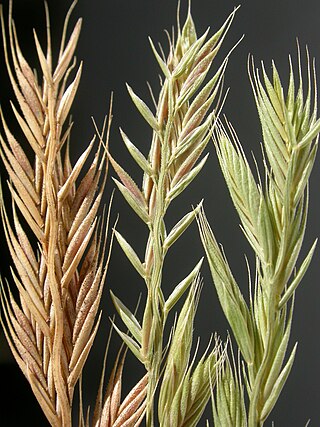
Festuca octoflora, also known as Vulpia octoflora, is an annual plant in the grass family (Poaceae). The common name six-week fescue is because it supplies about 6 weeks of cattle forage after a rain. Other common names include sixweeks fescue, six-weeks fescue, pullout grass, eight-flower six-weeks grass, or eight-flowered fescue.
Elachista caliginosa is a moth in the family Elachistidae. It was described by Parenti in 1983. It is found in Japan (Honshu) and the Russian Far East.
Frank Lamson-Scribner was an American botanist and pioneering plant pathologist. He was the first United States Department of Agriculture (USDA) scientist hired to study plant disease in economic plants and first USDA agrostologist.

Aeromachus inachus is a butterfly in the family Hesperiidae (Hesperiinae). It is found in the East Palearctic in Ussuri, Amur, Taiwan, Japan. The larva on feeds on Spodiopogon sibiricus and other Gramineae. There are two or more broods. The larva of this species hibernates.


















